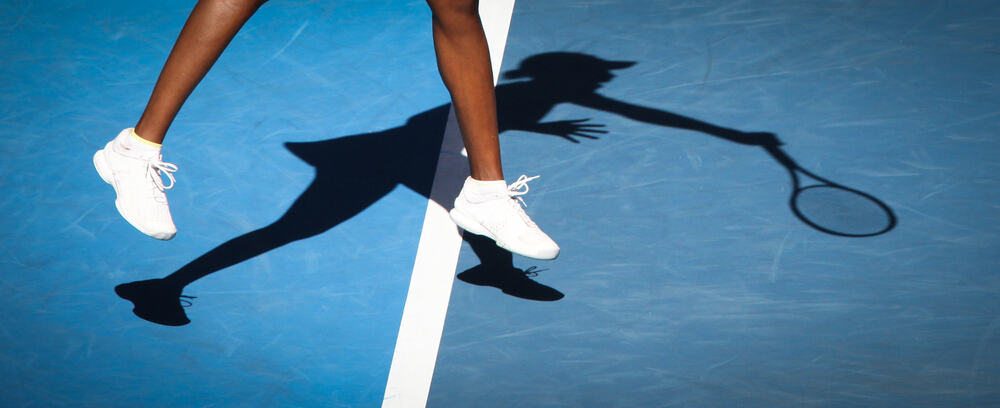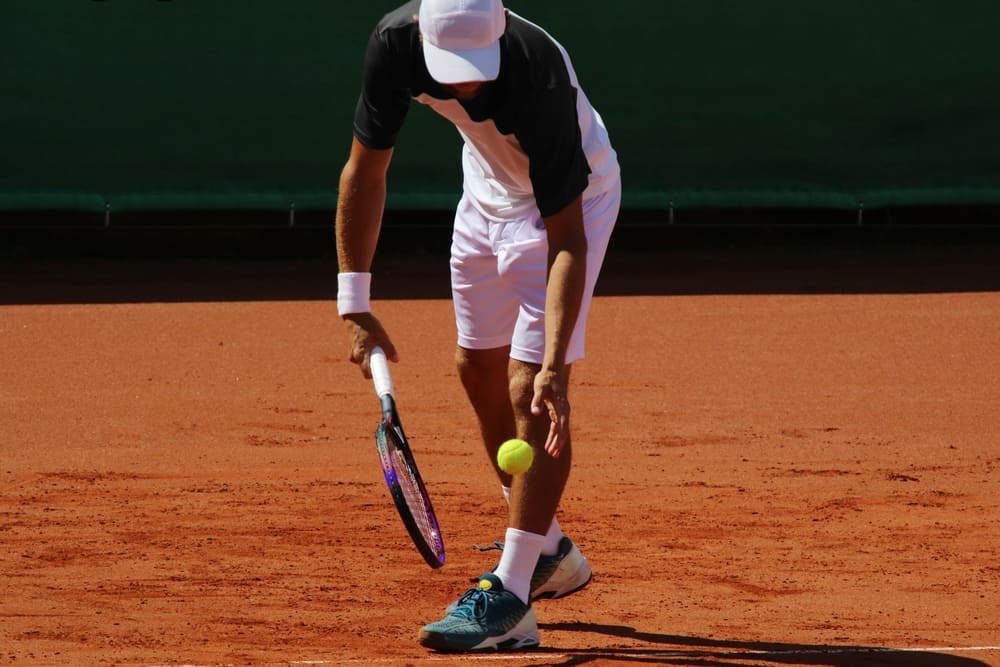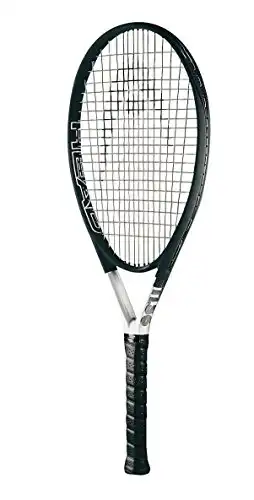What is a Foot Fault in Tennis
If you’ve ever wondered whether you can lose a point in a sport without actually playing, look no further than the foot fault in tennis. It’s rare to see a line judge call one in a professional match because players know to keep their front foot behind the baseline. However, foot faults happen, and they’re extremely agitating.
Key Takeaway:
A foot fault is a specific type of service fault in tennis where a player’s foot crosses the baseline or extension of the center line while serving. They’re in the same category as a normal fault, so if an umpire calls one on a first serve, the player gets a second serve. If it happens on a second serve, the player loses the point.
I’ll dive into more detail on how a foot faults in the rest of this article.
HEAD's Ti series has long been considered one of the best racquet series for beginners and the Ti S6 tops them all! It's a do-it-all type of racquet at a super affordable price!
The Tennis Foot Fault Rule
The International Tennis Federation defines a foot fault in the following way:
“During the service motion, the server shall not:
a. Change position by walking or running, although slight movements of the feet are permitted; or
b. Touch the baseline or the court with either foot; or
c. Touch the area outside the imaginary extension of the sideline with either foot; or
d. Touch the imaginary extension of the center mark with either foot.”
The rule ensures that all players are serving from the same place on the court. This puts everyone on a level playing field with the only additional advantage a player can gain over opponents coming from their natural height.
Most players avoid foot faults altogether by learning serving fundamentals and ensuring their front foot stays behind the baseline. However, they do happen occasionally when players push the limits.
Can You Jump Over the Line When Serving in Tennis?

You’re also not allowed to touch the baseline, centerline or the imaginary extension of the court. But what about jumping over that line?
You can jump over the line in tennis when serving as long as your feet do not touch the line before hitting the ball. Jumping forward into a serve is common for tennis serves and landing inside the court is perfectly legal. But you must make contact with the ball behind the service line.
How To Call a Foot Fault in Tennis
Calling a foot fault, a specific type of fault can be a little bit awkward for the line judge. After all, the foot might only be going over the line by a hair.
Players can get away with a lot when it comes to this rule. But when it needs to be called, there are generally line judges present to ensure fairness according to the rules of tennis.

The Line Judge Makes the Call
Amateur or Rec players aren’t likely to have this option. Hiring umpires costs money, and unless it’s a big tournament with sponsors, organizers aren’t likely to shell out. However, professional tournaments are all officiated by umpires.
When necessary, the umpire will call any foot faults. Opposing players may make complaints, but any decision comes down to the discretion of the match official.
Opposing Players Make the Call
For lower-profile matches played in smaller tournaments, officiating is largely based on the honor system. This isn’t such a big problem for normal faults or lets, but tension can arise when it comes to the foot fault.
Whether it’s a singles or doubles match, any opposing player can call foot faults. This can lead to arguments, so if there’s ever a disagreement, tournament officials can be called over to settle things.
Types of Foot Faults in Tennis
There isn’t just one type of foot fault to be aware of in the game of tennis. Below is a simple breakdown of the most common types of foot faults.
- Stepping on the baseline before hitting your serve is the most common foot fault.
- You must also avoid moving your feet by walking or running while serving; slight adjustments are okay, though.
- Another mistake includes stepping over the imaginary line extending from the center mark.
- Finally, ensure you don’t place your front feet outside the imaginary line extending from the sideline. This would mean you’re too far to that side.
Pro Tip: Keep practicing to perfect your serving stance!

The Consequences of a Foot Fault
If a player commits a foot fault during a match and an umpire or player calls them on it, the result is the same as any other fault.
Stepping over the line on a first serve results in a loss of that serve, regardless of whether they served the ball into the service box. The player would then serve their second serve.
If a player gets a foot fault on their second serve, the result is a double fault. They would then forfeit the point and continue with a new service point or a side out.
How Often Are Foot Faults Called in Tennis?
Foot faults are not often called in tennis. Typically, the umpire or opposing player will give a warning first, sometimes multiple warnings. If the player ignores those warnings, the umpire or tournament official will step in and issue a foot fault. Because of that, players usually obey the rules.
The foot fault isn’t a priority for most match officials. Unless a player is pushing the boundaries, they won’t call it.
Foot Faults in Professional Tennis
Since most umpires don’t pay much attention to foot faults, it can be frustrating for players when they do call them.
Just look at Serena Williams in the 2009 US Open. She was called for a foot fault by a lineswoman, which led to a temper tantrum and eventually a double fault.
And she’s not the only one. Professional players on the men’s and women’s tours are accustomed to a little bit of leeway when it comes to foot faults.
It makes sense to some degree. These are players who have been playing tennis for all their lives and have developed habits. Standing one centimeter (0.4 inches) over the line usually isn’t part of those habits, and it’s probably not going to win any points if the umpire lets it slide.
So, when foot faults are called, it leads to arguments.
Statistics on Foot Faults in Professional Tennis
While very rare, foot faults do happen in professional tennis. They don’t usually have the impact that the one called on Serena Williams had, but they are called.
Unfortunately, foot faults are so rare that they’re not even tracked as a statistic by the Women’s Tennis Association (WTA) or the Association of Tennis Professionals (ATP).
Even googling something like “Rafael Nadal foot faults” is more likely to fetch results talking about his foot injury.
They’re just not very common.
Foot Faults in Tennis – My Final Thoughts
While the foot fault rule is one that tennis players have to know about, it’s one of the easier ones to get your head around.
Get into good serving habits and you won’t have any issues with linesmen. That means starting your serve behind the line and away from the imaginary extension of the mid-court.
Other Common Foot Fault FAQs
Q: How can I play better tennis?
A: To improve your tennis game, focus on practicing regularly, working on your technique, getting guidance from a coach, and playing matches to gain experience.
Q: What are the common causes of a foot fault in tennis?
A: A foot fault occurs when the server’s foot crosses over the baseline or touches the court before hitting the serve. It can also happen if the server does not stand behind the service line or steps on the court during the serve.
Q: Is a foot fault considered a fault in tennis?
A: Yes, a foot fault is considered a fault in tennis. If a foot fault occurs, it results in a double fault, and the server loses the point.
Q: What is the role of USTA in handling foot faults?
A: The USTA (United States Tennis Association) sets rules and regulations regarding foot faults and other tennis violations. Players must adhere to these rules during matches.
Q: How can a player avoid committing foot faults during a tennis serve?
A: Players must stand behind the service line, avoid crossing over the baseline with their feet, and ensure that their back foot does not touch the court until after hitting the serve.
Q: What should a player do if they hit the net while attempting to hit a serve?
A: If a player hits the net while serving, it is considered a let. The player gets another chance to serve without any penalties.
Q: In tennis, when does a foot fault occur?
A: A foot fault occurs when the server’s foot crosses over the baseline or touches the court before hitting the serve. It is an infraction according to tennis rules.

Welcome to TheVolleyLlama.com. My name is Keith, I’m just a lover of all sports that involve a racquet, net and a ball. I played competitive high school varsity tennis, love racquetball and my whole family plays pickleball regularly. I started this website to help give people like you the basics to learn these wonderful games.


